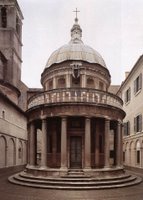Just back from a short (computerless) trip and feeling anxious that it's been so long since my last post. I think if I'm going to maintain a blog, I'll have to learn to let that worry go ... this is supposed to be a pleasure!
Following a thread in an art forum discussion this morning, I came across a clever blog entry that you might enjoy. I think the focus of this particular blog is a tad off-track for my interests, but this entry is fun.
http://www.paperlessundergrad.co.uk/pu/2006/02/putting_a_date_.html

One of the examples this blogger (named Rob) used to demonstrate his technique was Bramante's Tempietto, dated c.1502. I love this little structure and, if I have time, I always go see it when I'm in Rome First, Rob points out that the shape of the Tempietto is round =0. Then he noted the two shell reliefs in the niches flanking the central escutcheon on the upper drum = 2. Hence the memory aid for the date, '02.
The real advantage I see in using this embedded date approach is not so much as an assist in the memorization of precise dates -- which is a gripe of mine about how art history is so often taught. Rather, what I like about it is that it draws you in to study the painting or sculpture or architecture closely, so you really look at and think about the details. THIS is what art appreciation is all about!
No comments:
Post a Comment